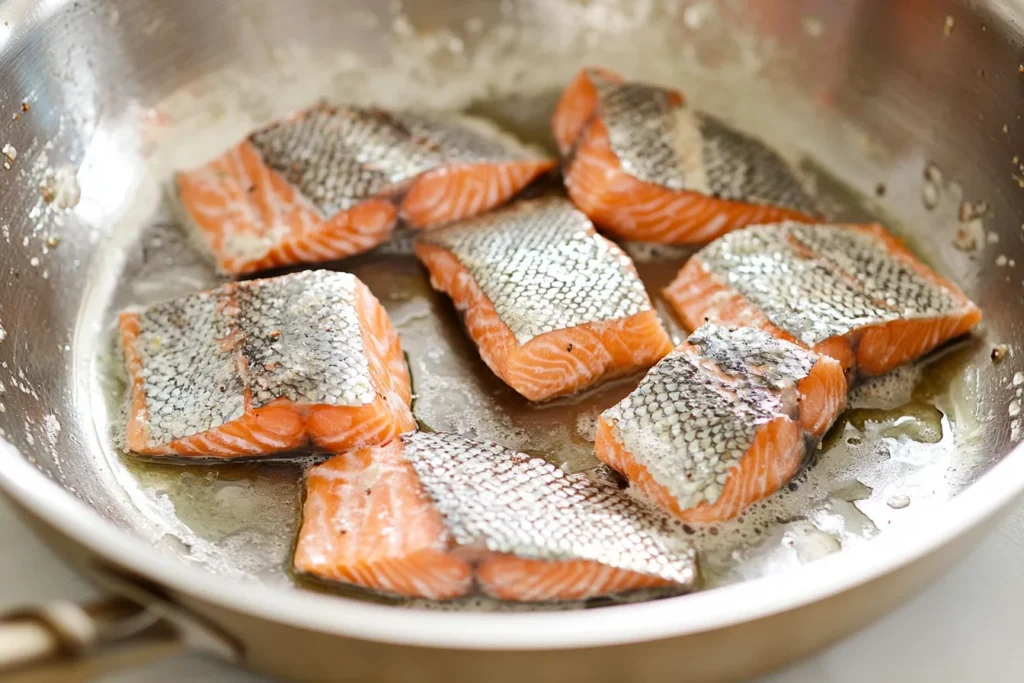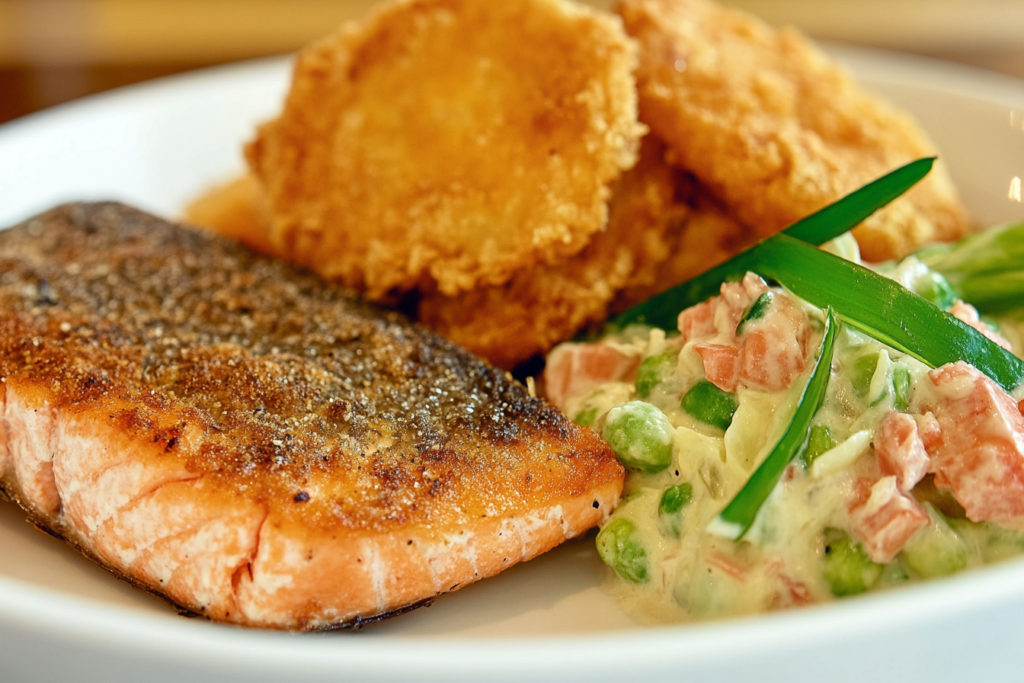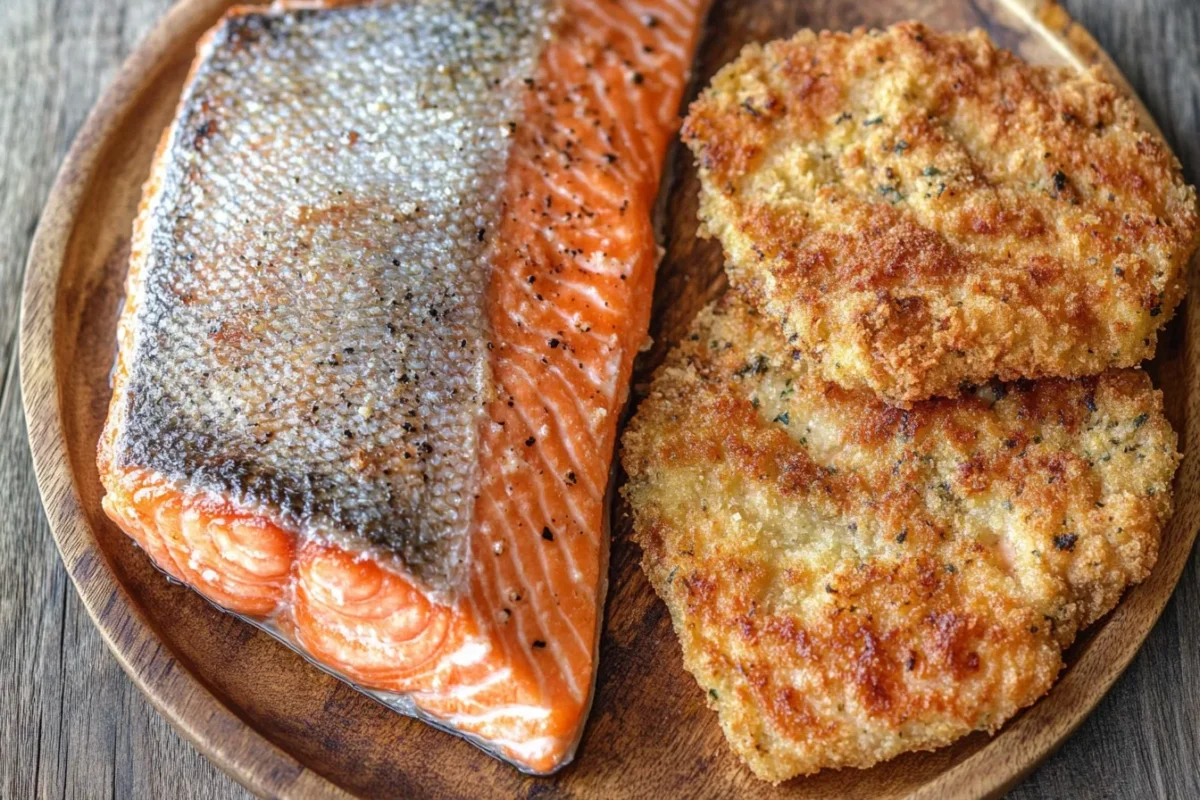Baked or fried salmon offers diverse flavors, textures, and health perks. Explore the best cooking methods for mouthwatering salmon dishes.
Welcome to this comprehensive guide on salmon, a favorite fish that’s prized for its flavor and versatility. Many home cooks wonder, Should salmon be baked or fried? This question arises because cooking techniques significantly affect nutritional value, taste, and texture. In the following sections, we’ll compare the differences between baked and fried salmon, explore their advantages and drawbacks, and help you decide which method best suits your preferences. We’ll also share valuable tips and answer your most pressing questions, so you’ll feel confident the next time you prepare a salmon dish.
By the end, you’ll have a clear understanding of how baking salmon can preserve moisture and health benefits, while frying can produce that crisp, golden exterior so many diners crave. We’ll delve into specifics like seasoning strategies, oil choices, and time management. Whether you’re new to cooking salmon or a seasoned chef, this article will offer plenty of insights to keep your meals fresh, nutritious, and delicious.
Should Salmon Be Baked or Fried? Understanding Key Differences
When discussing Should salmon be baked or fried? there’s no one-size-fits-all answer. Comparatively, each method has distinct qualities that may sway you one way or the other. Below, we’ll uncover a few fundamental differences that set these two techniques apart.
Nutritional Profile of Baked vs. Fried Salmon
Baking tends to preserve more nutrients. Conversely, frying can add extra calories from oil. Indeed, salmon is already rich in heart-healthy omega-3 fatty acids. When you bake it, you don’t typically use as much oil. Consequently, you can keep the dish lighter overall. Nonetheless, a moderate amount of frying oil doesn’t necessarily negate salmon’s health benefits. However, if you’re watching your calorie intake, baked salmon may be a smarter choice.
Altogether, the nutritional gap between baking and frying depends on how much oil you use. A small drizzle of olive oil or avocado oil for pan-frying can still yield a healthy meal. Nonetheless, be aware of portion sizes and other ingredients to balance your overall nutrient intake.
Cooking Times and Temperature Control
Should salmon be baked or fried? The decision often hinges on convenience. Generally, oven baking requires a simple process: preheat, season the salmon, then place it in a baking dish at around 375–400°F (190–205°C). Depending on thickness, salmon typically needs 12–15 minutes in the oven. Conversely, frying is faster, as it might take just 4–5 minutes per side. Nonetheless, you must watch the heat to prevent scorching.
Frying demands careful attention to the stove. Meanwhile, baking is more forgiving if you step away for a few moments. Comparatively, some people prefer the set-it-and-forget-it nature of baking for a more relaxed cooking experience.
Should salmon be baked or fried? Best Seasoning Practices
Proper seasoning can amplify your salmon’s natural flavor. When baking, consider using:
- Lemon juice or zest
- Herbs like dill, parsley, or thyme
- Light drizzles of olive oil
When frying, season lightly to avoid overpowering the fish. Salt, pepper, and a hint of garlic powder often suffice. Another trick is to marinate the salmon briefly, but make sure to pat it dry before frying. This ensures a crispy exterior.
Benefits of Baking Salmon
Understanding the pros of baking is crucial when you decide, Should salmon be baked or fried? Baking salmon has long been a favorite among health-conscious cooks, as well as anyone who values minimal cleanup.
Health Advantages
Salmon is famously nutritious, chiefly for its omega-3 content. When you bake it, you typically use less oil. Consequently, you reduce the total fat content of your dish. Additionally, baking allows the fish to retain moisture without charring the surface. Generally, fewer advanced glycation end products (AGEs) form during baking than frying. Thus, you may find it preferable for long-term health.
Furthermore, baking can be especially useful when cooking for a crowd. You can easily line up multiple fillets on a sheet pan. Particularly for those who enjoy meal prepping, baking helps you prepare several servings at once with minimal fuss.
Flavor and Texture
Baking salmon creates a moist and tender texture. However, don’t expect that crispy crust you’d get from frying. If you aim for a subtle flavor, baking is an excellent choice. Steam generated in the oven keeps the salmon juicy. Moreover, it lets flavors from herbs and spices meld into the fish.
For example, when you slather salmon with a mustard and herb mixture, the oven’s heat seals the flavors gently. Eventually, you’ll discover a delightful interplay of tastes in each bite. Comparatively, those who crave extra crispiness might lean toward frying or broiling. Nonetheless, baked salmon offers a cleaner, more delicate taste.
Should salmon be baked or fried? Best Side Dish Pairings
Baked salmon pairs well with:
- Roasted vegetables like asparagus or broccoli
- Whole grains such as quinoa or brown rice
- Light sauces, including yogurt-based dressings
Additionally, the mild flavors of baked salmon allow side dishes to shine. Whether you choose a colorful salad or a hearty sweet potato mash, your baked fish will complement a variety of plates. Indeed, the oven approach encourages a holistic, balanced meal that focuses on nutrient-dense foods.
Drawbacks and Considerations When Baking
While baking has numerous advantages, no method is perfect. When deciding Should salmon be baked or fried? it helps to weigh the potential challenges.
Potential Overcooking
Salmon can quickly become dry if left too long in the oven. Basically, over-baking robs the fish of its natural juiciness. Generally, you should keep an eye on your timer and check for doneness by flaking the fish gently with a fork. Equally important, consider using a meat thermometer for precise results. Aim for an internal temperature of about 145°F (63°C).
Comparatively, if you’re prone to forgetting what’s in the oven, you risk serving an overly dry dinner. Because salmon fillets are often thin, every minute can matter. Nonetheless, careful monitoring mitigates this issue.
Equipment and Cleanup
Baking typically calls for a baking sheet or dish, along with parchment paper or foil. Indeed, cleanup is straightforward if you line your sheet with parchment. However, if you don’t use protective layers, the fish’s oils can stick and cause stubborn residue.
Still, many home cooks prefer baking because you don’t have to monitor oil splatters. You pop the salmon in the oven, close the door, and wait for the timer. Afterward, disposing of parchment and washing one dish is generally simpler than scrubbing a skillet.
Should salmon be baked or fried? Common Mistakes to Avoid
- Over-seasoning: Baking intensifies flavors, so avoid drowning your salmon in strong spices.
- Not patting the fish dry: Even when baking, remove excess moisture to help seasoning adhere.
- Failing to preheat: A cold oven can alter cooking times and lead to uneven results.
Using these tips ensures a better experience. Consequently, you can make the most of baking’s healthy potential.
Should Salmon Be Baked or Fried? Essential Techniques Revealed
We return to the central question: Should salmon be baked or fried? Let’s reveal more specific techniques, particularly for those who love the crisp, golden surface only frying can deliver.
Frying Salmon for Maximum Crispiness

Frying salmon offers a delicious crunch that some diners adore. Initially, choose fillets with skin on if you prefer that crisp texture. Season them lightly, then place them in a hot pan with minimal oil. Leave the fish undisturbed for a few minutes to let the exterior develop color. Afterward, flip and cook the other side for an equally satisfying finish.
Conversely, if you remove the skin, you can still achieve a crispy edge. Chiefly, make sure the skillet is preheated, and the fish is adequately dried to avoid splattering.
Oil Choices and Temperature
Because salmon cooks fast, you want an oil with a relatively high smoke point. Thus, avocado oil or grapeseed oil are popular. Olive oil can work at medium heat, but watch for overheating. Another detail to consider is the flavor profile. Extra virgin olive oil imparts a distinctive taste, so if you prefer a neutral flavor, choose a milder oil.
Maintain a moderate-to-high temperature to lock in juices. Meanwhile, keep an eye on your fish so it doesn’t burn. Proper temperature control helps create an evenly cooked interior and a mouthwatering crust.
Should salmon be baked or fried? Ideal Seasoning Routines
When frying, a light marinade can intensify the flavor. Especially popular is a lemon-pepper or garlic-soy marinade. Nonetheless, drain excess liquid before the fish hits the pan. Patting the fillets dry reduces sputtering oil.
Alternatively, you can season right before cooking. Salt, pepper, paprika, or chili flakes add a pleasant kick. Because frying is quick, you can experiment with robust spices.
Benefits of Frying Salmon
While baking is frequently hailed as the healthy go-to method, frying has its own set of advantages. Particularly if you’re short on time, frying can be a lifesaver.
Taste and Texture
Fried salmon offers a contrasting texture: crispy outside, tender inside. Indeed, this distinction can make meals feel more indulgent. If you season the fish skillfully, you’ll enjoy a well-rounded taste profile. Moreover, frying can lock in moisture, giving you juicy fillets.
However, keep in mind that this crispness may require a bit of extra attention. Periodically check the fillet’s underside to ensure it’s not overdone. Nonetheless, once you master timing, frying can be a rewarding technique.
Quick Cooking
Time is often a deciding factor when asking Should salmon be baked or fried? Frying can cut your total cooking time significantly. You can pan-fry a salmon fillet in under 10 minutes. Meanwhile, you might wait 15 minutes or more for a baked fillet.
Likewise, a short cooking time means you can quickly whip up dinner after a long day. Indeed, for individuals who juggle busy schedules, fried salmon is a practical choice.
Health Considerations for Fried Fish
It might surprise you to learn that fried salmon can still be part of a balanced diet. The key is using healthy oils and moderate portions. For instance, a tablespoon of avocado oil distributed across several fillets doesn’t skyrocket your fat content. Furthermore, salmon’s inherent healthy fats remain beneficial.
Comparatively, you could enhance the meal’s nutritional profile by pairing fried salmon with a salad. Basically, the overall health factor depends on your entire plate, not just the cooking method. Therefore, frying doesn’t automatically mean unhealthy.
Drawbacks and Considerations When Frying
Before making a final call on Should salmon be baked or fried?, let’s cover the potential downsides of frying.
Calorie and Fat Content
Unquestionably, frying can introduce more calories from oil. Especially if you use too much, your dish may become greasy. While salmon itself is nutrient-rich, overdoing the oil can overshadow its benefits. Consequently, consider measuring your oil precisely. A small portion can go a long way.
Possible Flavor Overwhelm
Salmon has a robust flavor already. Frying, particularly if you use strongly flavored oils or heavy spices, might overpower its natural taste. Moreover, a thicker crisp can mask the fish’s delicate characteristics. Nonetheless, if you enjoy bold flavors, this might be a perk rather than a drawback.
Cleanup and Odor
Unlike baking, frying typically leaves oil splatters around the stove. You may need to wipe down surfaces. Plus, the lingering smell can be potent. Meanwhile, running a fan or opening windows helps, but it’s still a consideration if you’re sensitive to cooking odors. Altogether, the inconvenience of cleaning might deter some cooks from frying
Should Salmon Be Baked or Fried? Final Thoughts on Flavor and Texture
The decision to bake or fry salmon boils down to personal preference. Nonetheless, understanding the trade-offs helps you choose methodically. If you’re still asking, Should salmon be baked or fried? consider the following final insights.
Balancing Health and Taste
Nutritionally, baked salmon edges out fried salmon due to lower oil usage. However, frying with healthy oils can still produce a nutritious meal. Particularly when balanced with wholesome sides, the difference may not be extreme. Consequently, your overarching dietary habits matter more than a single cooking method.
Personal Preferences and Flexibility
Different households have different priorities. Some people crave a crunchy bite. Others prioritize minimal cleanup. Equally, time constraints and cooking confidence levels influence the decision. Baking might be simpler for beginners, whereas frying often requires a bit more skill and vigilance.
There’s no one correct answer to Should salmon be baked or fried? Indeed, variety can keep your meals exciting. You might bake salmon one day for a tender, flaky experience and fry it another day for a crispy texture.
Conclusion and Recommendation
So, Should salmon be baked or fried? Ultimately, both methods can produce delicious outcomes. If you’re leaning toward health benefits and fuss-free cleanup, baking is your friend. If you prefer quick cooking and crave crispiness, frying may be the way to go. In reality, many people enjoy alternating between both techniques based on their mood and circumstances.
Regardless of your choice, focus on using high-quality salmon, fresh herbs, and the right amount of oil or seasoning. That way, your fish will remain flavorful and nutrient-dense. Indeed, salmon is a versatile fish, so don’t be afraid to experiment. By combining knowledge of various cooking methods, you’ll become confident in preparing salmon that pleases any palate.

Frequently Asked Questions (FAQs)
Is it better to bake salmon or fry it?
It depends on your goals and preferences. Baking is often seen as healthier because it uses less oil and produces a moist, tender texture. Frying, however, gives you a crispy exterior and speeds up the cooking process. Both are delicious if done correctly.
What is the best cooking method for salmon?
The best method varies by personal taste and time constraints. Baking offers a gentle, hands-off approach with less cleanup. Frying requires more attention but yields a crunchy finish. You can also experiment with broiling, grilling, or poaching. Ultimately, the best method is the one that suits your taste, lifestyle, and skill level.
Is salmon better in the oven or air fryer?
An air fryer can replicate the crispiness of fried salmon with less oil. Generally, cooking times are shorter, and results can be similar to pan-frying. However, an oven may allow you to cook more fillets simultaneously. Either way, you’re likely to achieve a tasty meal.
Is baked salmon healthier than fried?
In general, yes. Baking uses minimal additional fat, which keeps calorie and oil intake lower. Yet, frying salmon in a moderate amount of healthy oil can still fit into a balanced diet. Pay attention to portion sizes, sides, and your overall eating patterns for the healthiest results.
FOR MORE DELICIOUS RECIPES:

